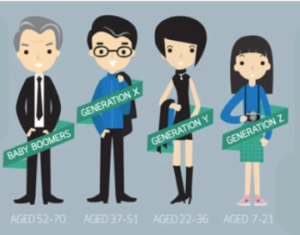
Intergenerational communication refers to how different generations interact with one another. Each generation has been shaped by unique historical events, technological advancements, and cultural shifts that influence their communication styles. Understanding these differences is crucial for fostering effective communication across age groups.
Baby Boomers (Born 1946-1964)
Baby Boomers grew up during a time of significant social change, including the civil rights movement and the Vietnam War. Their communication style tends to be more formal and direct. They value face-to-face interactions and often prefer traditional forms of communication such as phone calls or in-person meetings over digital methods. This generation places a high value on loyalty and respect within professional settings, often leading them to use hierarchical structures in their communications.
Key characteristics of Baby Boomer communication include:
- Preference for verbal communication over written.
- Use of formal language and titles.
- Emphasis on personal relationships and trust-building.
Generation X (Born 1965-1980)
Generation X is often characterized as the “middle child” between Baby Boomers and Millennials. They experienced the rise of technology but also remember a time before it was ubiquitous. As a result, their communication style is more adaptable than that of Baby Boomers. Gen Xers are comfortable with both traditional and digital forms of communication but often prefer email or text messages for quick exchanges.
Key characteristics of Generation X communication include:
- A balanced approach between formal and informal language.
- Preference for concise messages.
- Value is placed on work-life balance, leading to more casual interactions.
Millennials (Born 1981-1996)
Millennials have grown up in an era dominated by technology and social media. Their communication style is heavily influenced by digital platforms like Facebook, Twitter, and Instagram. They tend to favor informal language and are accustomed to rapid exchanges of information through texts or instant messaging apps.
Key characteristics of Millennial communication include:
- Use of emojis and informal language.
- Preference for visual content (images/videos) over text.
- Strong inclination towards collaboration and feedback.
Generation Z (Born 1997-Present)
Generation Z is the first generation to grow up entirely in the digital age. Their communication style reflects this upbringing; they are highly adept at interacting with various digital platforms. Gen Z tends to communicate through short-form content such as TikTok videos or Snapchat messages rather than lengthy emails or phone calls.
Key characteristics of Generation Z communication include:
- Preference for visual storytelling (memes, GIFs).
- High reliance on social media for interaction.
- The desire for authenticity and transparency in communications.
Conclusion: Bridging Communication Gaps
Understanding these generational differences can help bridge gaps in intergenerational communication. Organizations can benefit from training programs emphasizing these differences to improve teamwork among diverse age groups. Individuals can adapt their approaches by recognizing each generation’s preferred styles—whether it’s Baby Boomers’ preference for face-to-face meetings or Gen Z’s inclination towards visual content.

Recent Comments